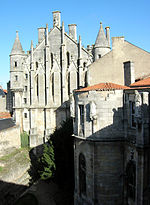University of Poitiers
1430s establishments in France1431 establishments in EuropeEducational institutions established in the 15th centuryPublic universities in FranceUniversities and colleges in Poitiers ... and 1 more
University of Poitiers
The University of Poitiers (UP; French: Université de Poitiers) is a public university located in Poitiers, France. It is a member of the Coimbra Group. It is multidisciplinary and contributes to making Poitiers the city with the highest student/inhabitant ratio in France by welcoming nearly 28,000 students in 2017. The University of Poitiers represents a global operating budget of around 150 million euros per year, one-third of which is for operating and investment costs and two-thirds for personnel costs. As of July 2015 it is a member of the regional university association Leonardo da Vinci consolidated University.
Excerpt from the Wikipedia article University of Poitiers (License: CC BY-SA 3.0, Authors).University of Poitiers
Rue Franklin, Poitiers
Geographical coordinates (GPS) Address Nearby Places Show on map
Geographical coordinates (GPS)
| Latitude | Longitude |
|---|---|
| N 46.586111111111 ° | E 0.34388888888889 ° |
Address
Rue Franklin 10
86000 Poitiers
Nouvelle-Aquitaine, France
Open on Google Maps







